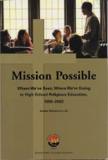The Adolescent Faith Journey
I first met James DiGiacomo, S.J., in the mid-70’s at a national workshop he was leading for the Jesuit Secondary Education Association on adolescent moral development. In 2003 he retired from a teaching career that spanned more than five decades. His dedication to Catholic religious education within a church and a society rife with change was a tremendous inspiration. He writes about his experiences, both the joys and the challenges, in Mission Possible.
As a young teacher I can remember vividly the aha! moment I experienced while listening to Father DiGiacomo explain Lawrence Kohlberg’s stages of moral development. My freshmen and I had just watched scenes from A Man for All Seasons, and I was in near despair because many of them could not wrap their minds around Thomas More’s refusal to take the Oath of Supremacy and get King Henry VIII off his back. But Ms. Collins, what good is he going to accomplish if he’s dead? Or, But Ms. Collins, the oath is just a piece of paper. Can’t Thomas More just tell God he doesn’t really mean it? Won’t God understand?
Father DiGiacomo offered wonderfully concrete explanations of how teenagers grow in their ability to consider the transcendental elements of a moral choice. My students were not morally bankruptthey were just 14! But as a teacher, I needed to do what DiGiacomo suggested: think about what questions, what analogies, what connections to their own lives I could offer my students so they might be able to imagine what could possibly motivate a man like Thomas More. Like a good son of Ignatius Loyola, DiGiacomo was following the methodology of the Spiritual Exercises: listen carefully to the soul in front of you and adapt, adapt, adapt.
The same creative resilience he displayed in that workshop years ago shines brilliantly in his book. In Mission Possible he models this careful listening by offering striking quotations from his students’ own writings. Using their voices and his own memories, DiGiacomo paints a vivid picture of the sea change that has convulsed American Catholic religious education. Since incongruence is at the heart of all humor, the reader should be prepared to laugh out loud. DiGiacomo’s book is filled with stories that point to how absurd we humans can be when we attempt to grapple with the divine. He spoofs the legalism of the church of the 1950’s, but is always keenly aware of the vacuum created when Catholics lost sight of the rules.
From the 1960’s onward, he notes in a chapter called A Wild Ride, the God of judgment was replaced by the God who does not get cranky. While happy to toss out the guilt and minimalism of pre-Vatican II Catholicism, DiGiacomo acutely dissects the problem of the Domesticated Divinity:
Where did this do-nothing God come from? For several decades now, youth ministers have been assuring adolescents that God loves them unconditionally. This is a true and powerful message. But...some of them hear God loves me so much, he doesn’t care what I do.
Laying this laissez-faire God on the doorstop of youth ministers is a little unfair. In the first decades after Vatican II, there were a lot of us swept up in a feel good sort of faith. We were told and we believed that God could be experienced, God wanted to be known. On the flip side, as God became more accessible, eager to tell us don’t sweat the small stuff, we did not see the serpent’s tail rounding the corner. Most loving, as most service, is all about the small stuff.
Mission Possible, as the subtitle suggests, moves through the 70’s (Focusing on the Learner), the 80’s (Religious Consumerism), the 90’s (Civil Disagreement) and The New Millennium. The book is autobiographical and anecdotal. But more, it is a chronicle of 50 years during which DiGiacomo passed along the faith to generations of young Catholics. Over the course of 30 years, he traveled throughout the country and abroad speaking with and encouraging parents, youth ministers and religious educators, often through graduate programs and workshops.
In my experience, one image of God that resonates effectively with teenagers is that of the Trinity, loving parents who respect the freedom of their adult children to make choices and live with the consequences of those choices. Older teens can begin to understand Johann Metz’s sage comment: We can no longer do theology with our backs to Auschwitz. Our freedom is terrible in its power; and we become, as individuals and as a society, the sum total of our choices. I don’t think, in the main, Father DiGiacomo could disagree with that.
This article also appeared in print, under the headline “The Adolescent Faith Journey,” in the September 20, 2004, issue.








